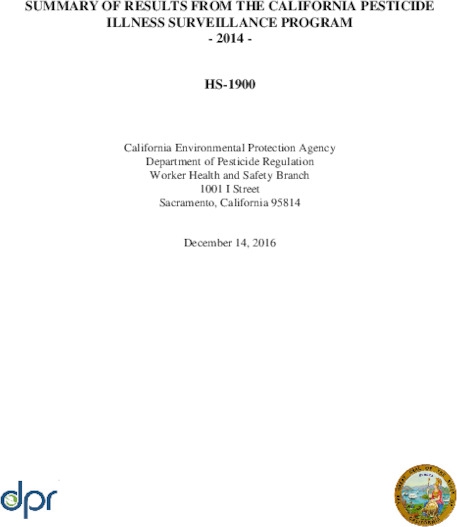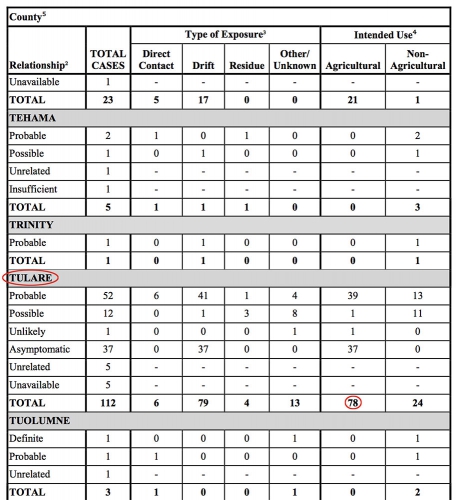From the Open-Publishing Calendar
From the Open-Publishing Newswire
Indybay Feature
California
Central Valley
Santa Cruz Indymedia
Environment & Forest Defense
Government & Elections
Health, Housing & Public Services
Santa Cruz County has second most agricultural pesticide illnesses in the state
Department of Pesticide Regulation report shows Santa Cruz County ranked #2 for agricultural pesticide-related illnesses in 2014
Watsonville, CA – The California Department of Pesticide Regulation (DPR) released a report last week detailing the 2014 results of their Pesticide Illness Surveillance Program. The report, documenting all reported pesticide-related illnesses from all California counties, shows 17.2% of agricultural pesticide-related illnesses occurred in Santa Cruz County, making it the county with the second-most agricultural pesticide illnesses in the state. Of the 53 counties with documented pesticide-related illnesses in 2014, Santa Cruz County accounted for over 1 in every 6 cases of poisonings from agricultural pesticides.
In Santa Cruz County, DPR investigated a total of 67 agricultural-related pesticide poisonings, a starkly high number compared to other agricultural counties. Their report also notes the type of exposure associated with each investigated illness, with drift accounting for 85% of all pesticide-related illnesses in Santa Cruz County.
“It is concerning to us that a relatively small county has such a large proportion of illnesses related to agricultural pesticides,” says Lucia Calderon, organizer of the coalition Safe Ag Safe Schools. “Especially in a place where treated fields are so close to schools and neighborhoods, it is crucial that the DPR takes action to truly reduce the incidence of pesticide drift and subsequent poisonings.”
DPR recently proposed policy that would enact part-time, ¼-mile buffer zones around schools and licensed child care facilities for the most drift-prone application methods, including fumigations. But a 2011 report by state and federal health departments of California and other states titled “Acute Pesticide Illness Associated with Off-Target Pesticide Drift from Agricultural Applications: 11 States, 1998- 2006” found that 82% of the fumigant-related cases, for which distance data were available, occurred more than ¼-mile away from the application site.
“A ¼-mile is not enough to protect from pesticide drift and illness. To protect public health and make sure agricultural pesticide illness is truly reduced, Santa Cruz County and the entire state need full-time, full-mile buffer zones around schools,” says Calderon.
###
Safe Ag Safe Schools is a coalition of 50-plus organizations and individuals working together to reduce pesticide exposure threats to the Monterey Bay region’s residents.
In Santa Cruz County, DPR investigated a total of 67 agricultural-related pesticide poisonings, a starkly high number compared to other agricultural counties. Their report also notes the type of exposure associated with each investigated illness, with drift accounting for 85% of all pesticide-related illnesses in Santa Cruz County.
“It is concerning to us that a relatively small county has such a large proportion of illnesses related to agricultural pesticides,” says Lucia Calderon, organizer of the coalition Safe Ag Safe Schools. “Especially in a place where treated fields are so close to schools and neighborhoods, it is crucial that the DPR takes action to truly reduce the incidence of pesticide drift and subsequent poisonings.”
DPR recently proposed policy that would enact part-time, ¼-mile buffer zones around schools and licensed child care facilities for the most drift-prone application methods, including fumigations. But a 2011 report by state and federal health departments of California and other states titled “Acute Pesticide Illness Associated with Off-Target Pesticide Drift from Agricultural Applications: 11 States, 1998- 2006” found that 82% of the fumigant-related cases, for which distance data were available, occurred more than ¼-mile away from the application site.
“A ¼-mile is not enough to protect from pesticide drift and illness. To protect public health and make sure agricultural pesticide illness is truly reduced, Santa Cruz County and the entire state need full-time, full-mile buffer zones around schools,” says Calderon.
###
Safe Ag Safe Schools is a coalition of 50-plus organizations and individuals working together to reduce pesticide exposure threats to the Monterey Bay region’s residents.
For more information:
https://www.facebook.com/safeagsafeschools/
Add Your Comments
We are 100% volunteer and depend on your participation to sustain our efforts!
Get Involved
If you'd like to help with maintaining or developing the website, contact us.
Publish
Publish your stories and upcoming events on Indybay.
Topics
More
Search Indybay's Archives
Advanced Search
►
▼
IMC Network







